The Article
DISCO ANTISTAT MK.II+: THE NEXT GENERATION
29th August 2024
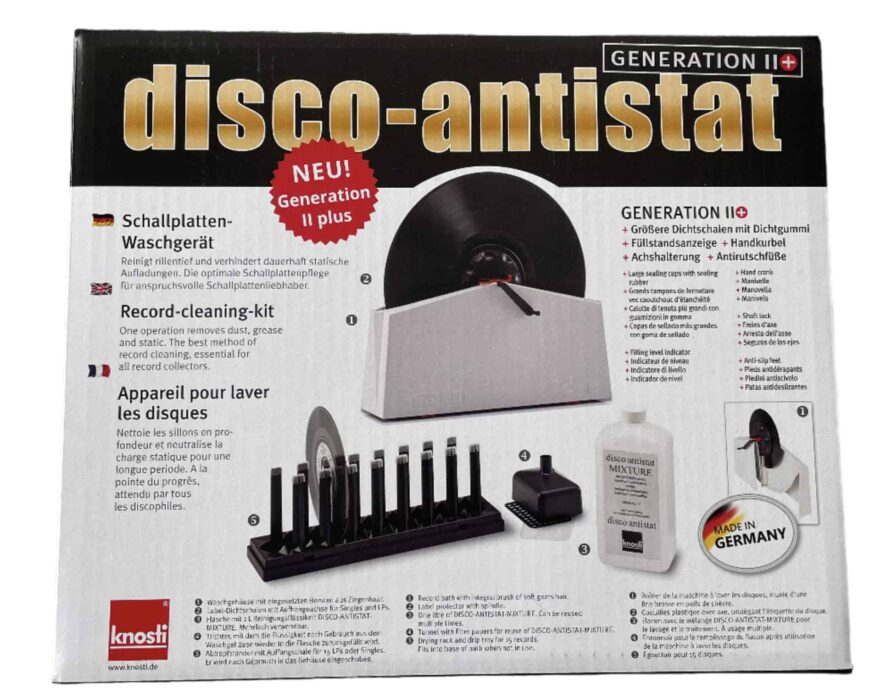
Taking the basic Disco Antistat manual vinyl record cleaner, Paul Rigby checks out the Mk.II+ upgrade from Knosti
The original Disco Antistat Mk.I manual vinyl cleaning machine is a stone-cold, 24 karat, classic. In my opinion, the very best, low-cost, manual vinyl record cleaner you can buy. Period. Built to a price it might be but all of the important design factors are there. Using the correct liquids and secondary tools, the Disco-Antistat is a giant-killer of a cleaning system.
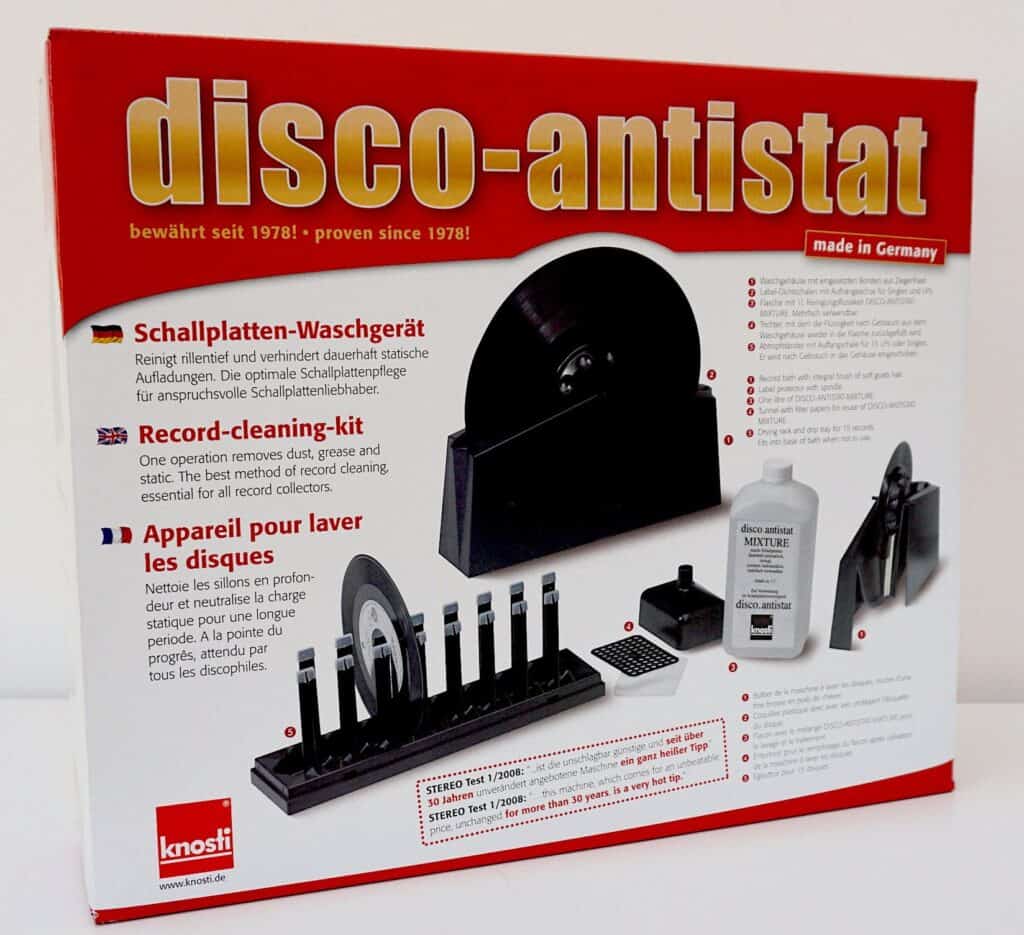
Question. Can the new iteration, the improved Mk.II+ follow in its footsteps? Will the new Mk.II+ be the new king of the hill? That’s what we are here to find out.
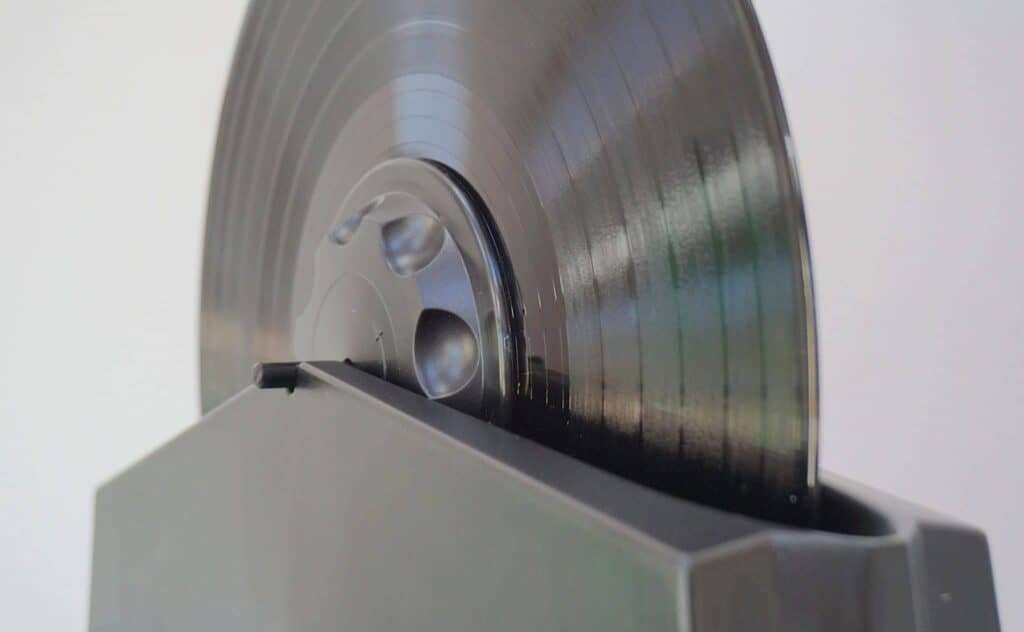
In this feature, I am not going to tell you how to use the basic Disco Antistat. I already have a feature which goes into all of that with the original Mk.I, so I won’t repeat myself here.
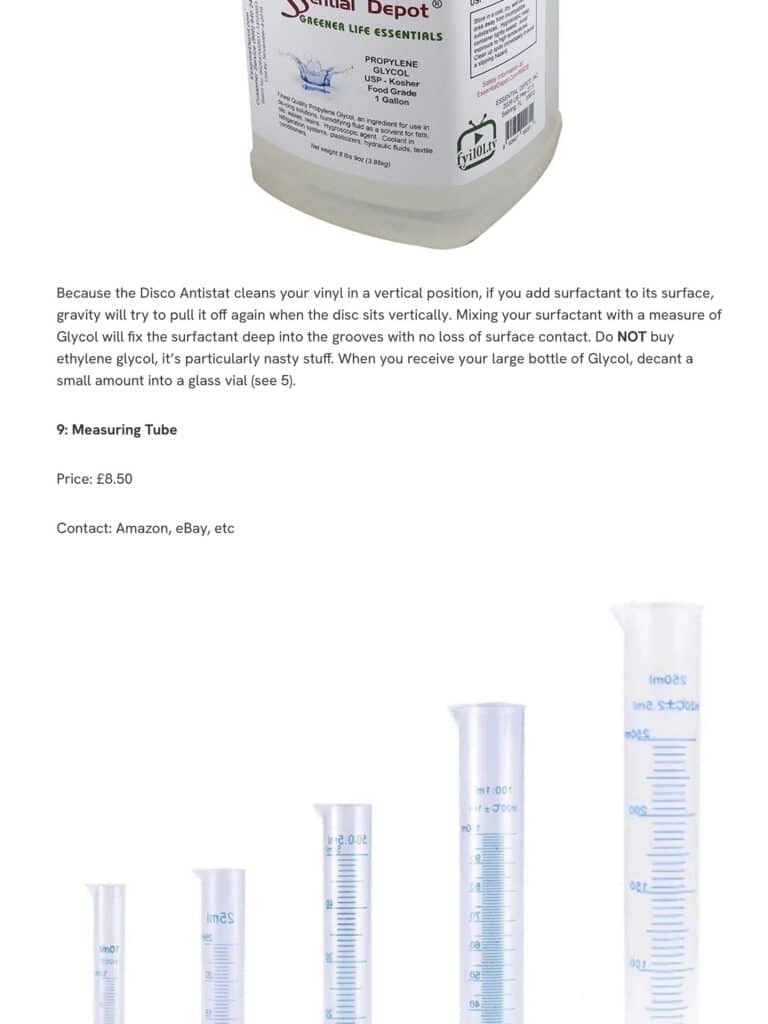
I am also not even going to tell you how to get the best from the Disco Antistat. See that link above which features my own, in-depth, 5000 plus word cleaning guide that’s supported by two videos and backed by years of development, interviews and research.
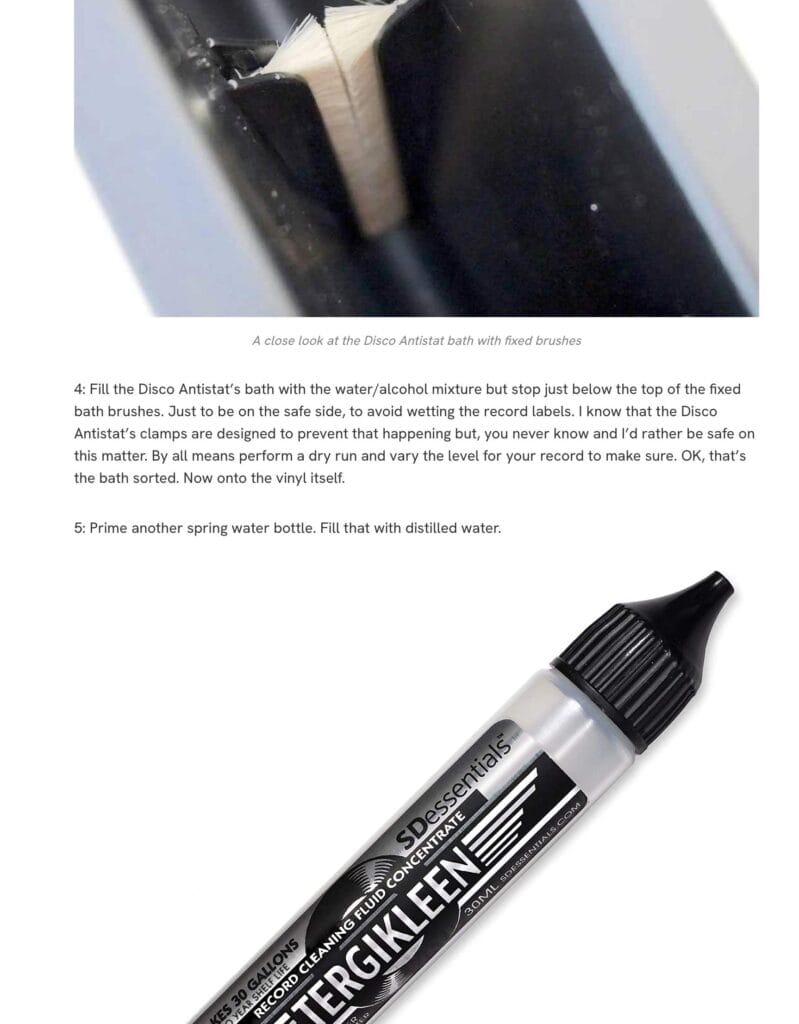
So, if we’re not doing any of that, what are we doing? What is this review about? Differences. This review is basically a differences piece. It tells you how the Mk.I has been changed, upgraded or otherwise and why. Any issues or problems I might see and how they might be rectified or not. I also offer my advice on if you should buy a Mk.II at all or whether you should just stick to the Mk.I.
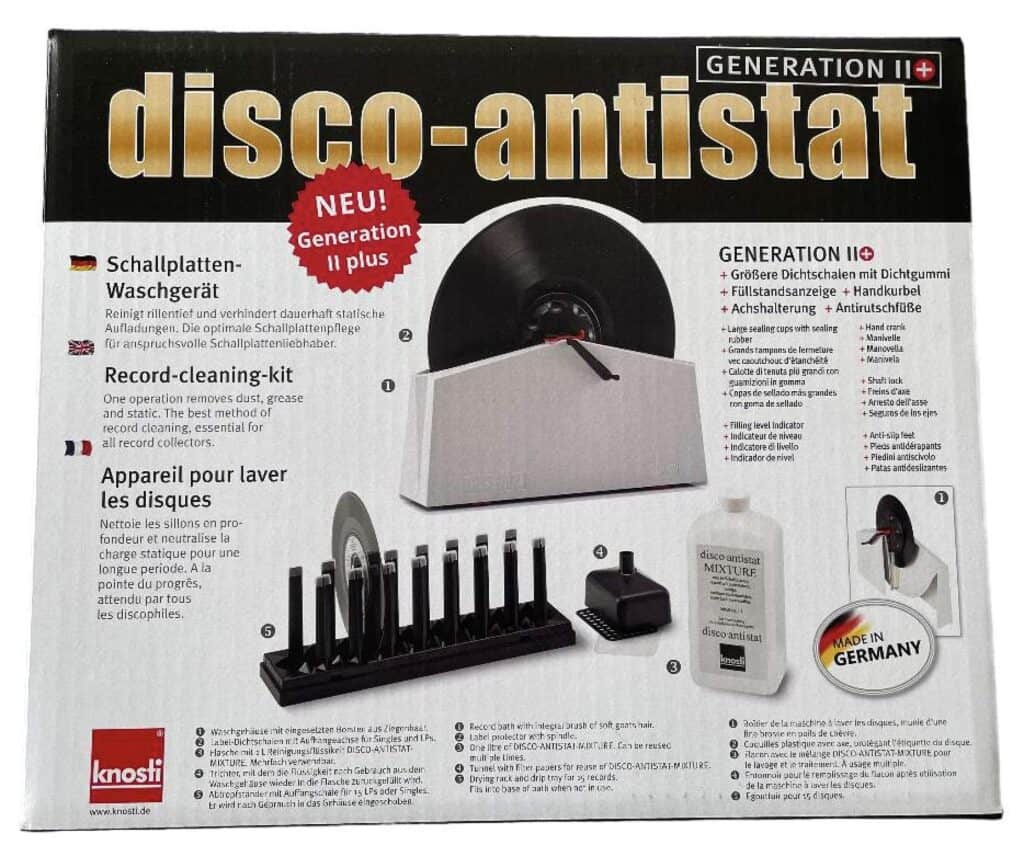
So, to coin a movie phrase? What’s in the box?
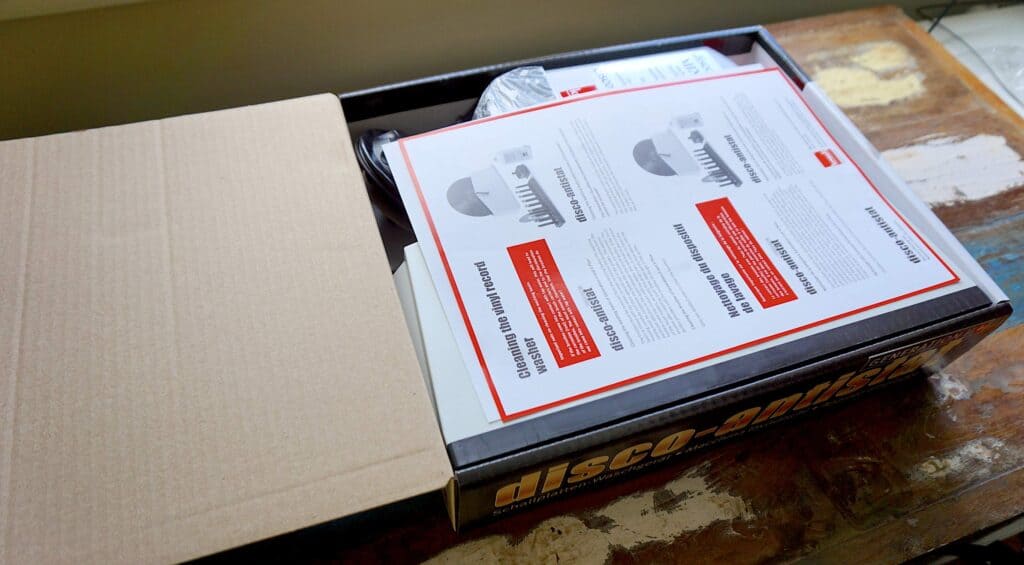
Underneath the instruction sheet, you will notice the bath, the clamp to attach to your mucky record, top left, a water filter box and accessories to filter out nasty mucky bits from the bath water and a bottle of cleaning liquid.
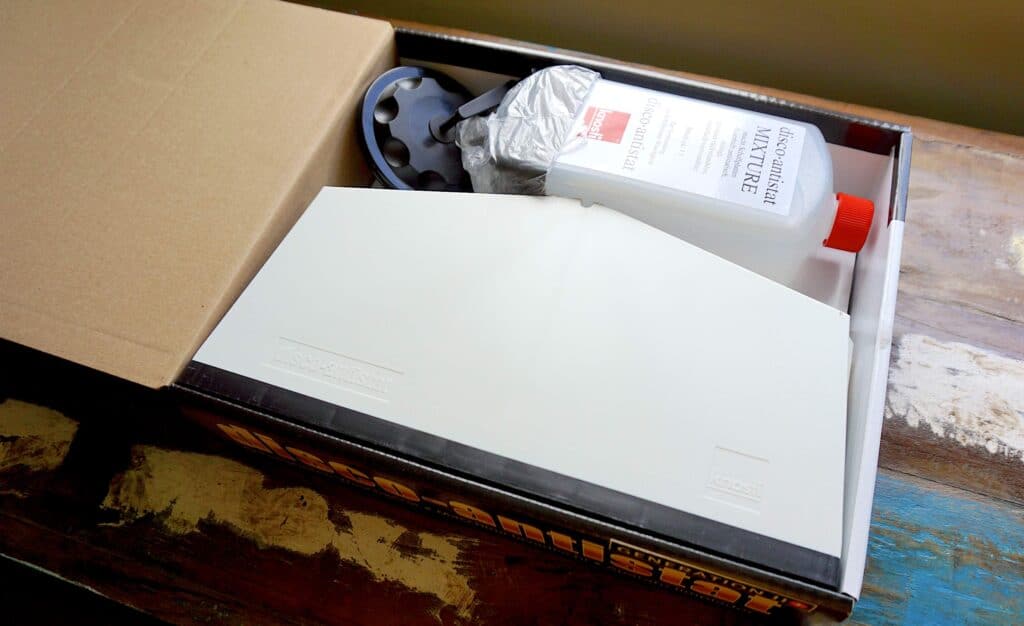
Tucked inside the plastic bath is a box of accessories but we’ll get to those later.
LIQUID IN A BOTTLE
Before we get to the hardware itself, I want to talk about the included cleaning liquid, offered in a tough plastic bottle which contains a pre-diluted liquid solution. That is, the liquid itself is ready to pour into the bath of the a Mk.II+, ready to clean your vinyl.
When I reviewed the Mk.I Disco Antistat, many years ago now, I frowned upon the included liquid, at that time. Why? Because the liquid left a thick, gloopy deposit, a residue in the grooves which was collected by the stylus tip during play which then needed removing by a stylus cleaner.
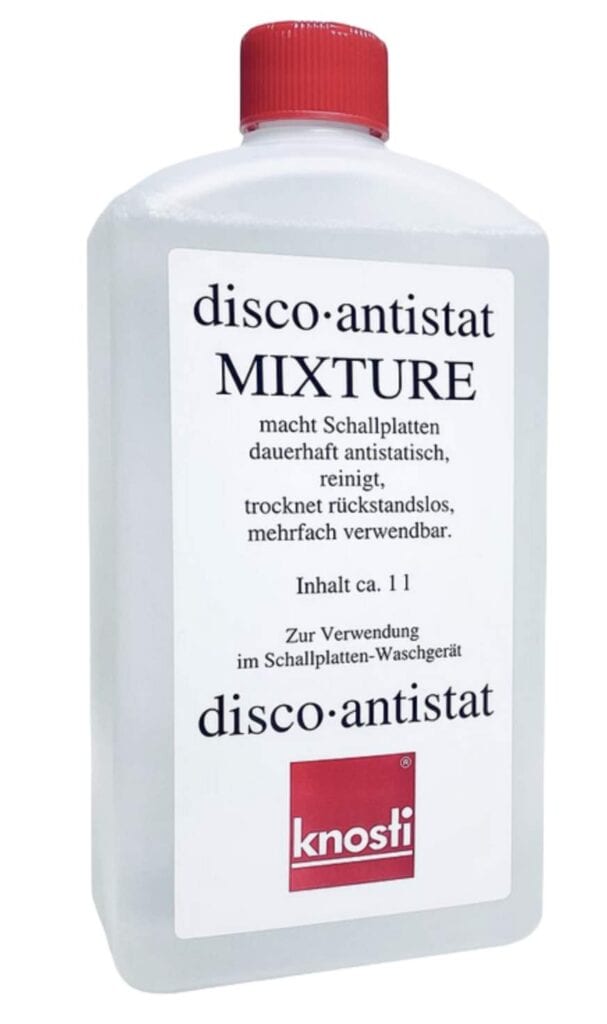
This stuff seemed to never end, there seemed to be tons of the stuff, it just kept on coming and my stylus tip at at the time was being clogged and cleaned every five minutes. So I binned the featured Knosti liquid and used my own preparation.
Well, that liquid has now been modified. I know that the alcohol has been removed from it but what else may have been tweaked? And was that included Knosti alcohol reacting with other bottled ingredients to generate the gloop? Hence, will the removal of the alcohol stop that gloopy thing going on?
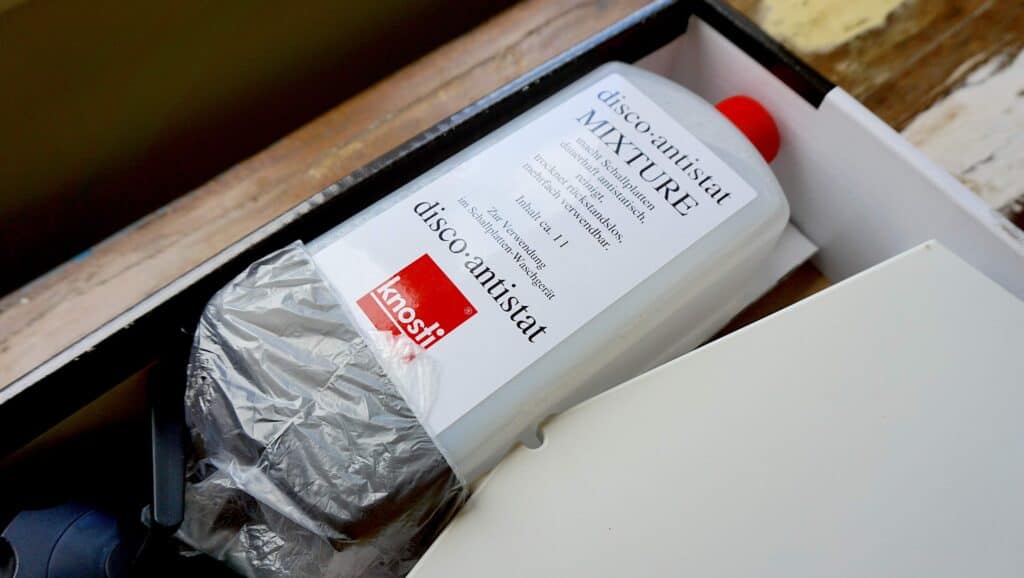
So I tested that. What I did not do was grab my nearest mucky record to clean that to see if the gloop reappeared. After all, any possible deposit on the stylus tip might be from the liquid. Then again, it might also be from the dirty corners of the record’s own grooves. So no, I needed to be sure.
What I did first, was to clean, not one, but two test records in my Degritter Mk.II ultrasonic cleaner. Then I gave that same records a rinse in my Degritter Mk.II.
Then I played those cleaned records on my turntable and examined the stylus tip to see if any deposit occurred on the stylus tip from mucky grooves. Once I was happy that no natural deposit was occurring, then and only then did I “clean” those records in the newly tweaked Disco Antistat liquid.
LIQUID RESULTS?
Better. Not perfect. Improved, you might say. I did see some deposit collecting on the stylus tip as a result of cleaning with the Knosti cleaning liquid. Not as much as I saw with the original liquid recipe, but it is there. If you have a zero tolerance for such things (as I do) then keep using your own cleaning alternative. The improvements have done nothing to change my own mind, I will still be using my own liquid concoction, for example.
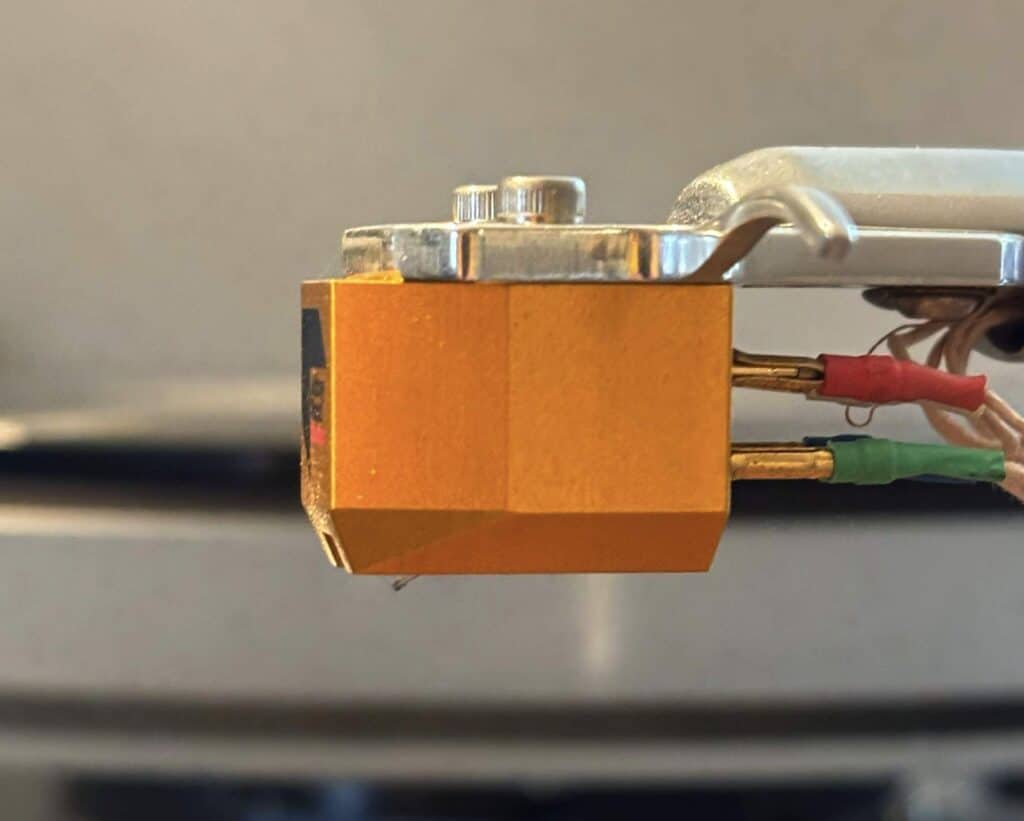
Even so, if you don’t want to faff around with third-party liquids and the like and just want to get on with it? Then sure, the Knosti liquid is now usable. You may find yourself cleaning your stylus now and again but at least the situation is somewhat…bearable.
But look, this product is really not about the liquid. Its about the hardware. Let’s look at that.
THE BATH
First up? I like the lighter, grey colour.
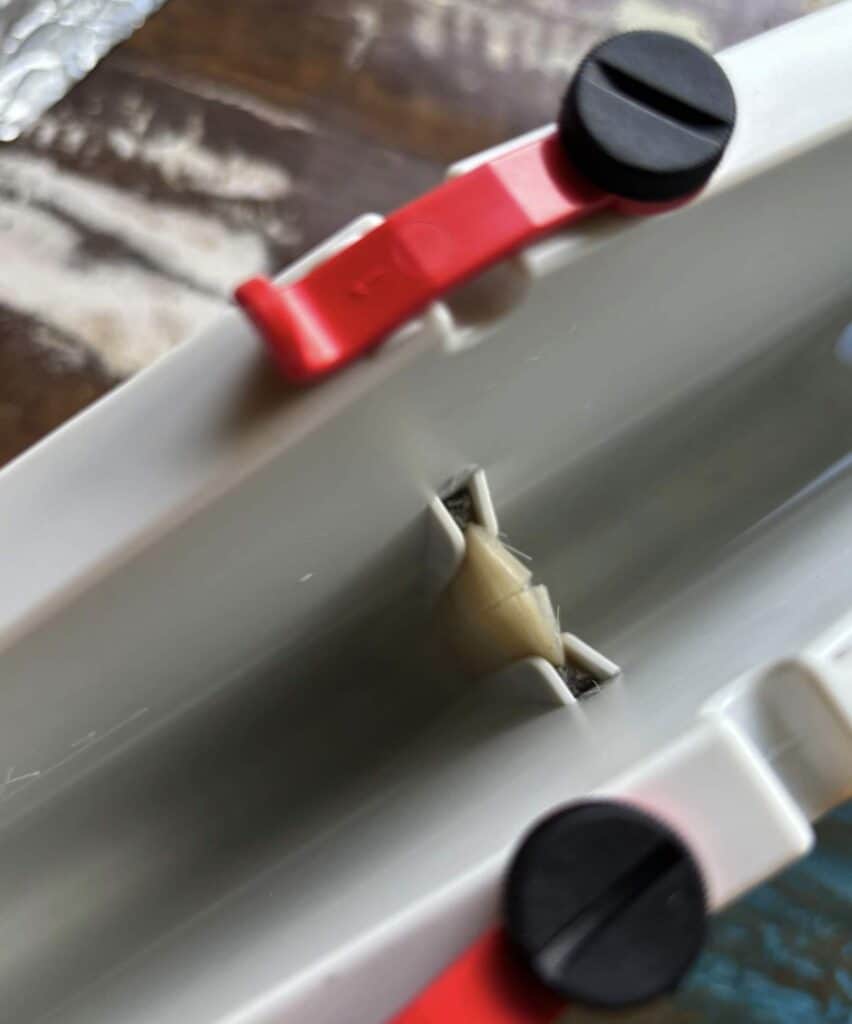
Why? Because you now have a better chance of seeing what’s going on in the bath, how mucky it might be and if the bath water needs changing.
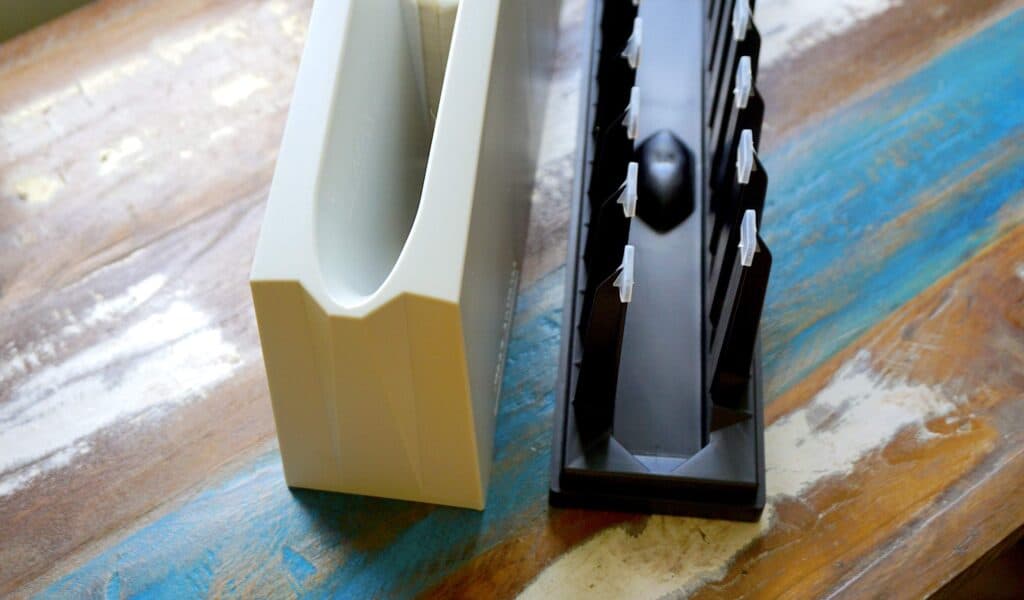
Also, if there are particularly large pieces of grime floating around so maybe that bath water change should be changed sooner than you would normally change it and if the brushes are dirty and need a clean and so on.
WATER LEVEL
Also, on the inside of the bath wall is a MAX level water mark which is immensely helpful to prevent over-filling the bath and thus risk soaking the clamp that is protecting your record’s label. If I was being greedy, I would have liked a MIN level to plus an AVERAGE or NORMAL level.
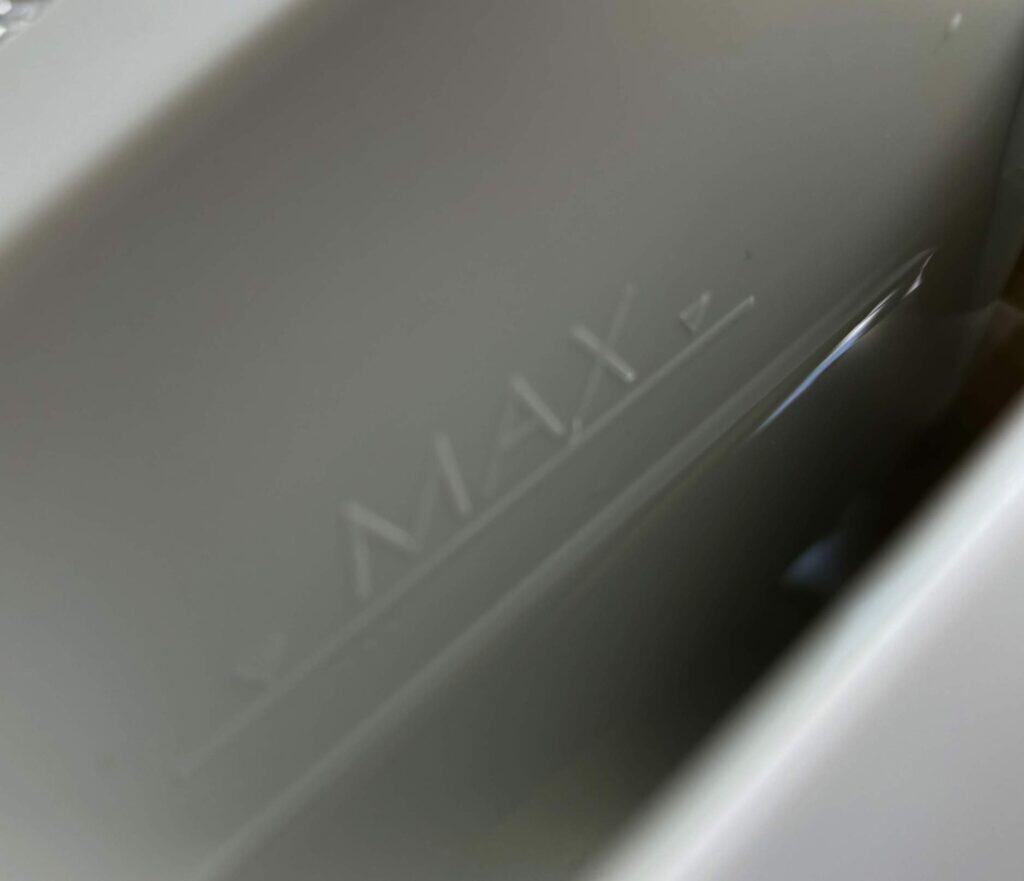
The MIN level indicating how much the Mk.II+ requires to operate in the first place and the NORMAL level indicating how much water most people will need to do a typical cleaning job. But MAX and MIN labels would be my priority.
BRUSHES
Next up is the secret sauce of the Disco Antistat, the brushes. These brushes do all the good work and add one thing that all of its competitors do not: abrasion. Critical in cleaning and oft ignored by most other cleaning systems out there except for ultrasonics. See more about abrasion in my Cleaning Guide (link above).
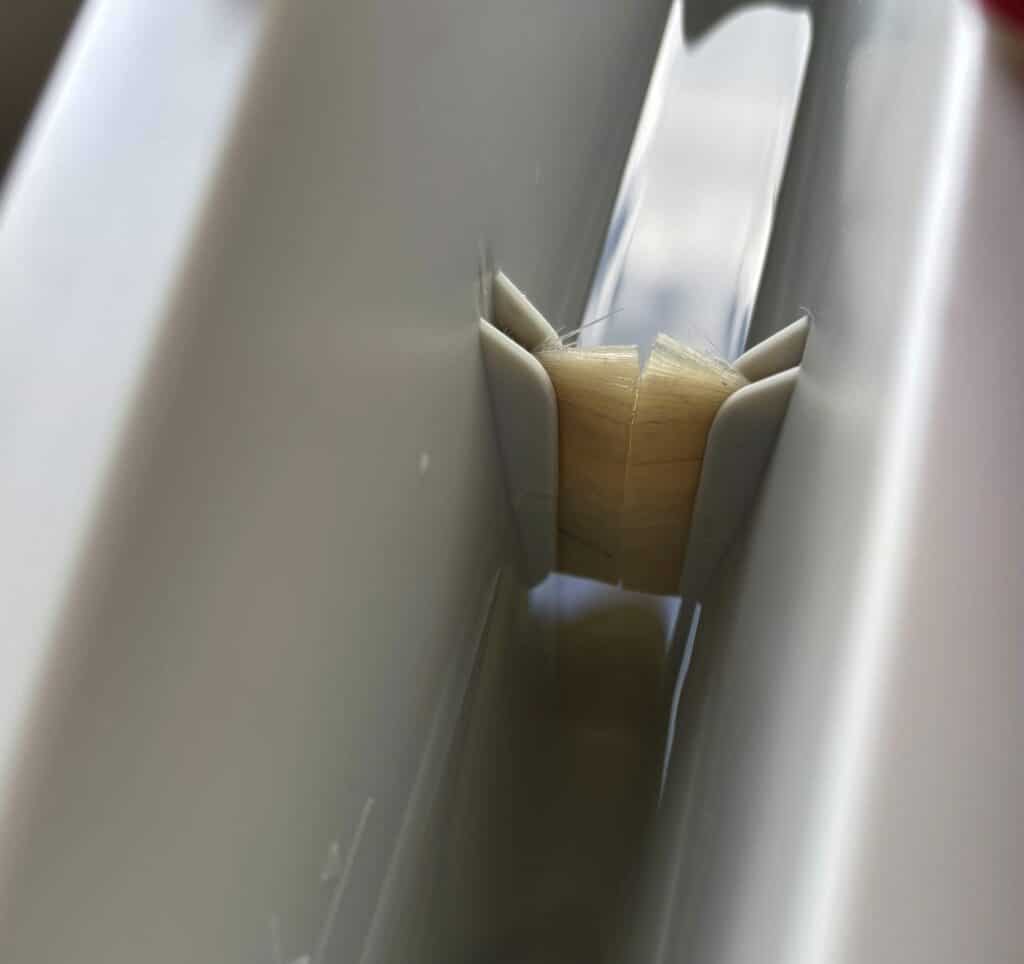
Goat hair is the substance of choice here. I asked Knosti why they ended up with goat hair and it said, “Over the course of time, we have tested various bristle materials and the goat hair bristles have proven themselves time and time again due to their good properties and excellent cleaning results, coming out on first place in the tests. It would perhaps be easier to work with synthetic fibres, as goat hair as a natural product always has slight variations but we did not want to choose the easiest way, but the most efficient with the best result.”
The great thing about the Mk.II+ is that you can now remove these brushes, one at a time, for cleaning which is a brilliant addition.
COMPLAINTS
I did notice two complaints on the Internet regarding the brushes. Firstly, that some people couldn’t shift them, they had trouble removing the removable brushes from the bath itself. They even had problems while using a pair of pliers. For these commentators, their brushes were stuck solid.
Well, maybe the Mk.II+ has redesigned the housing or I got lucky because I found their removal and reinstallation super easy. Very smooth indeed. Perfect, actually. So moving the brushes on my Mk.II+? Not a problem.
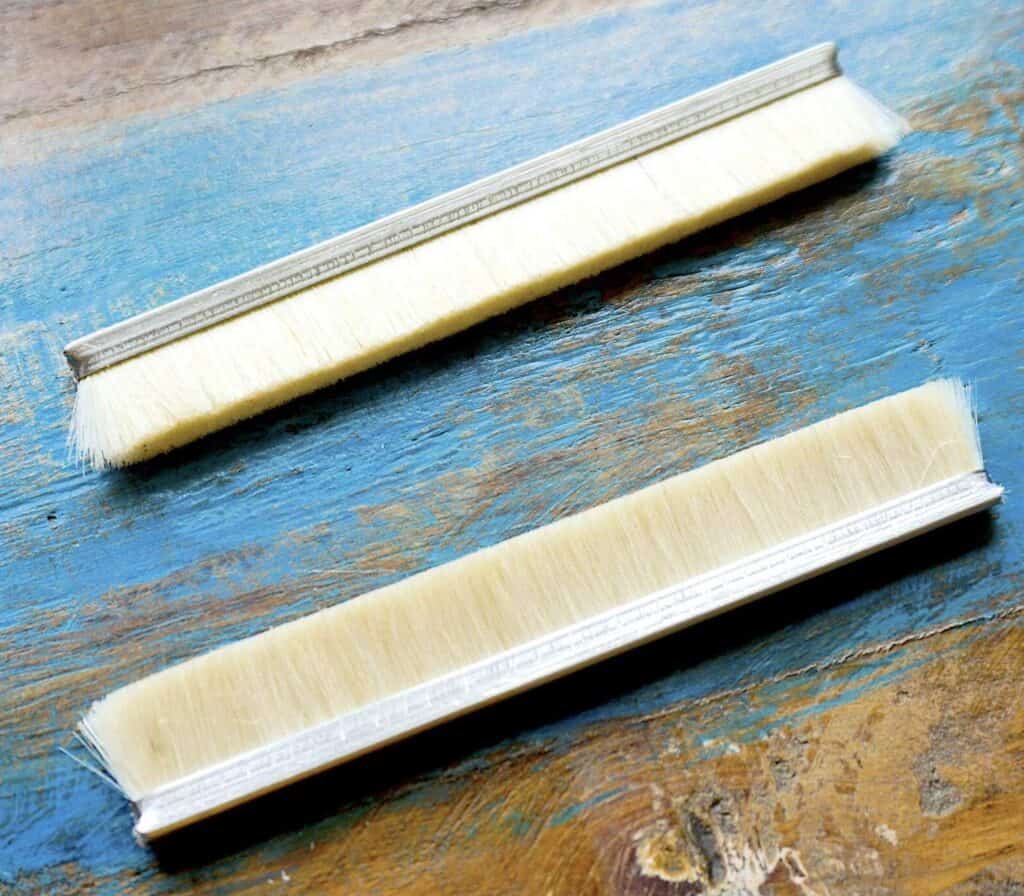
The next complaint I saw was that some users found rusting in the brush area itself. I asked Knosti about this and it said that the brush housing is made from stainless steel, so any rust isn’t coming from there.
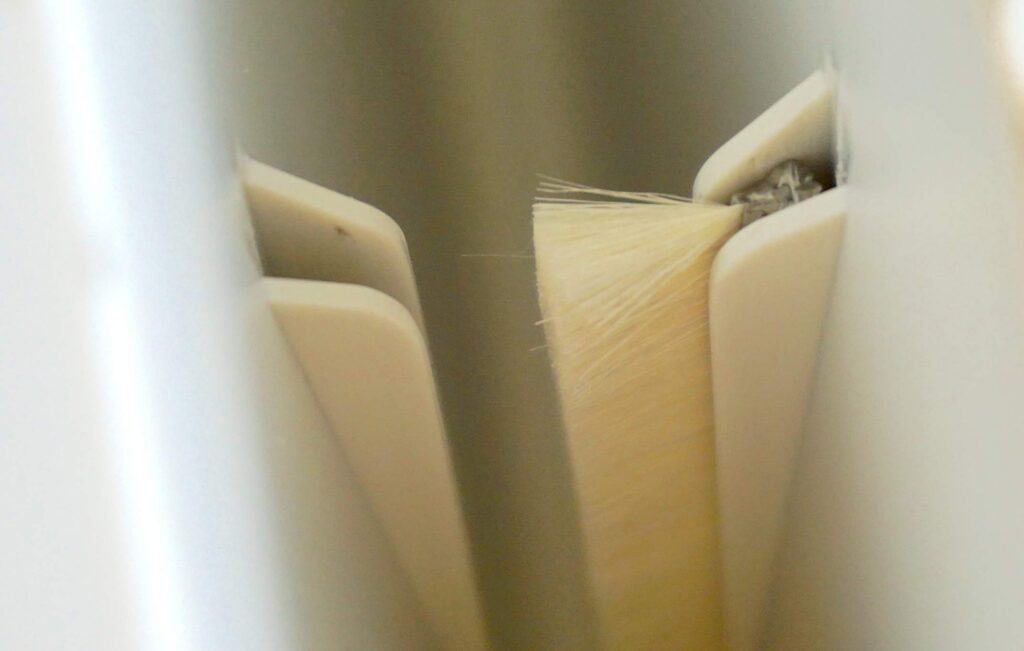
Knosti said that the source of any rust spots found in this area could be a result of the manufacturing process where dust and other contaminants have accumulated around the brush area.
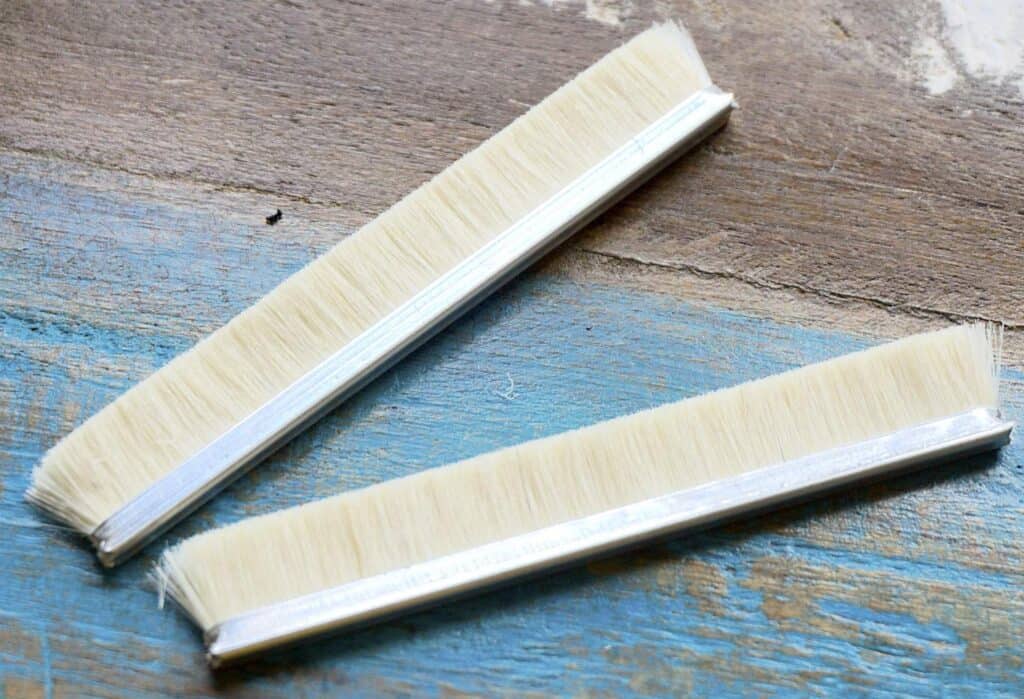
The advice then? Before you use the Mk.II+ bath, remove the brushes, give them a good clean, clean the inside of the bath (and outside while you’re there, dry thoroughly), and that should solve the Case of the Rusty Bath (which sounds very Sherlock Holmes, I must say).
FEET
Next? Underneath, Knosti has given you two sets of feet, one for each end of the bath chassis. You have to construct the feet but that is super easy. Just take the two plastic blocks. Remove the sticky black feet from their backing material, add those to the feet blocks and then push the foot blocks underneath the bath chassis and you are done. They stay in place by friction alone.
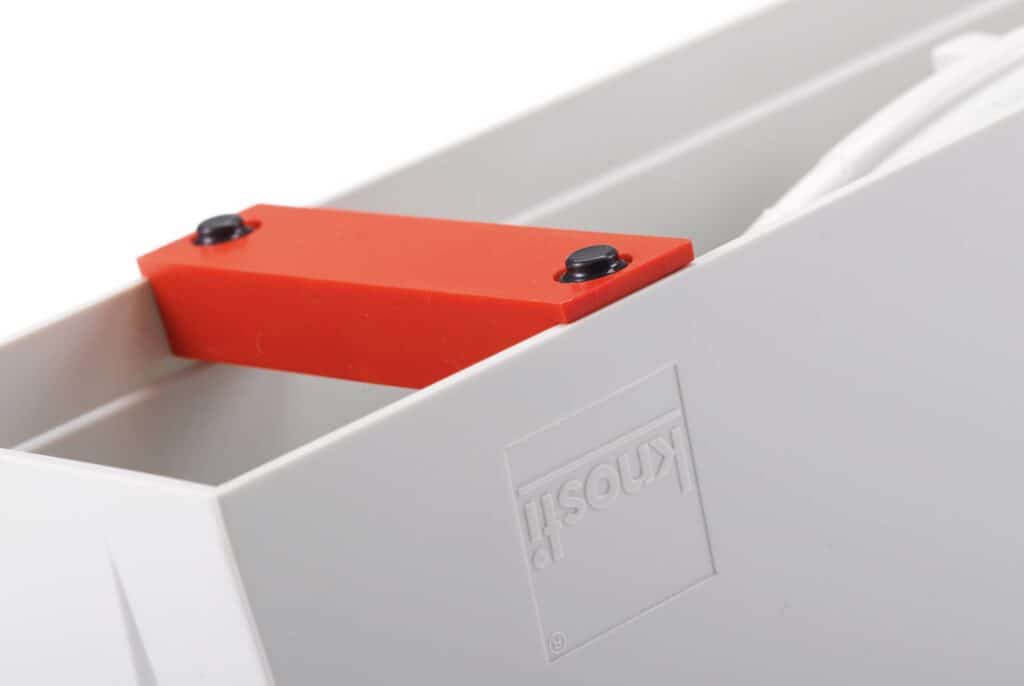
Having the feet in place is a great addition because the original Disco Antistat had no feet all so it slid all over the desk surface, especially if you have removed the drying rack.
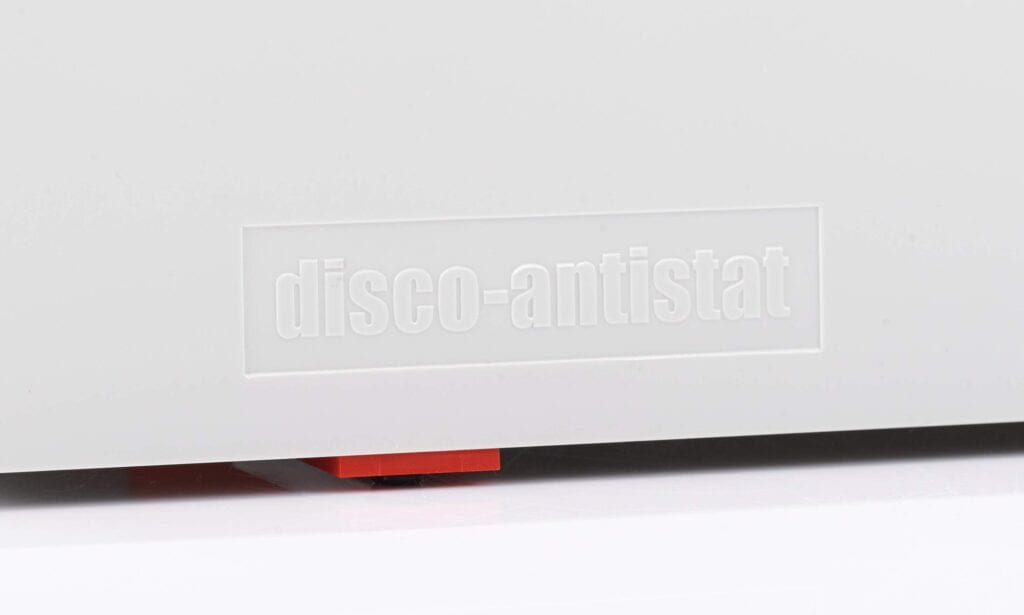
The Mk.II+ feet are designed to be fit in place once the drying rack has been removed. They work very well indeed.
CLAMP
Before we get to the clamp, I must mention the two new shaft locks. The locks are to be found in the accompanying packet of accessories, found in the box.
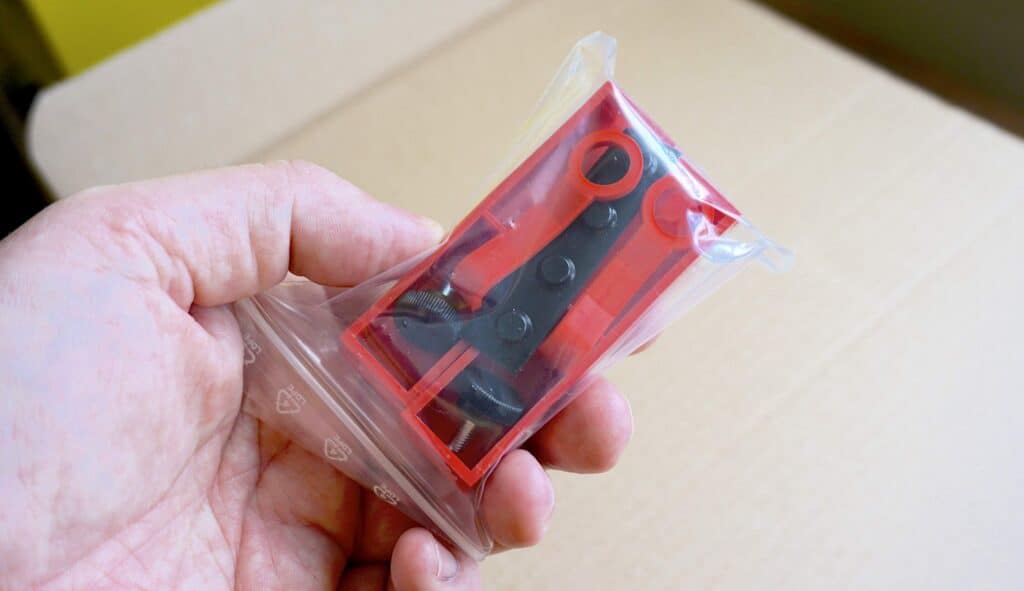
Consisting of two shaped pieces of plastic, they are affixed to the bath chassis with a grub screw.
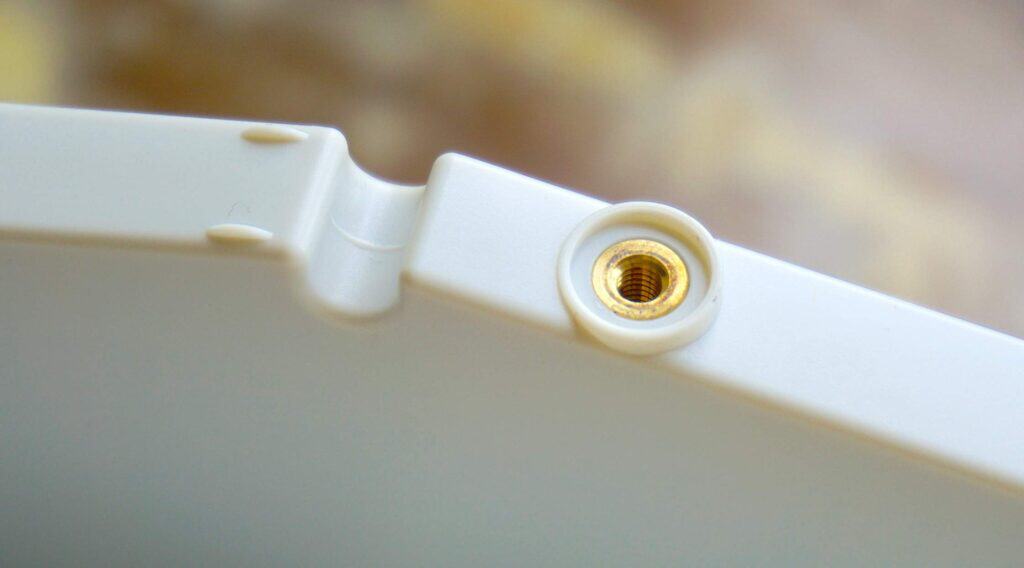
They then swing around and over the clamp to stop it popping out of the axle grooves during cleaning.
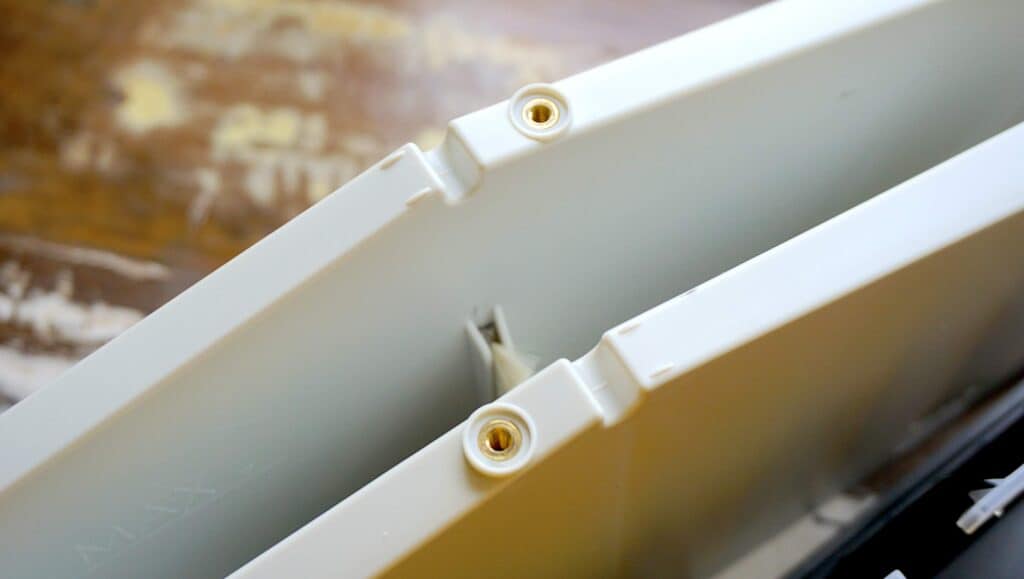
The clamp itself now features a handle so you can turn the clamp with that instead of having to grasp the record itself and rotate the record. This will be useful for those people who didn’t want to get their fingers wet, it avoids some records which could be a little sharp around the outer edge when moving with bare hands and it also keeps the record free of hand-borne oils.
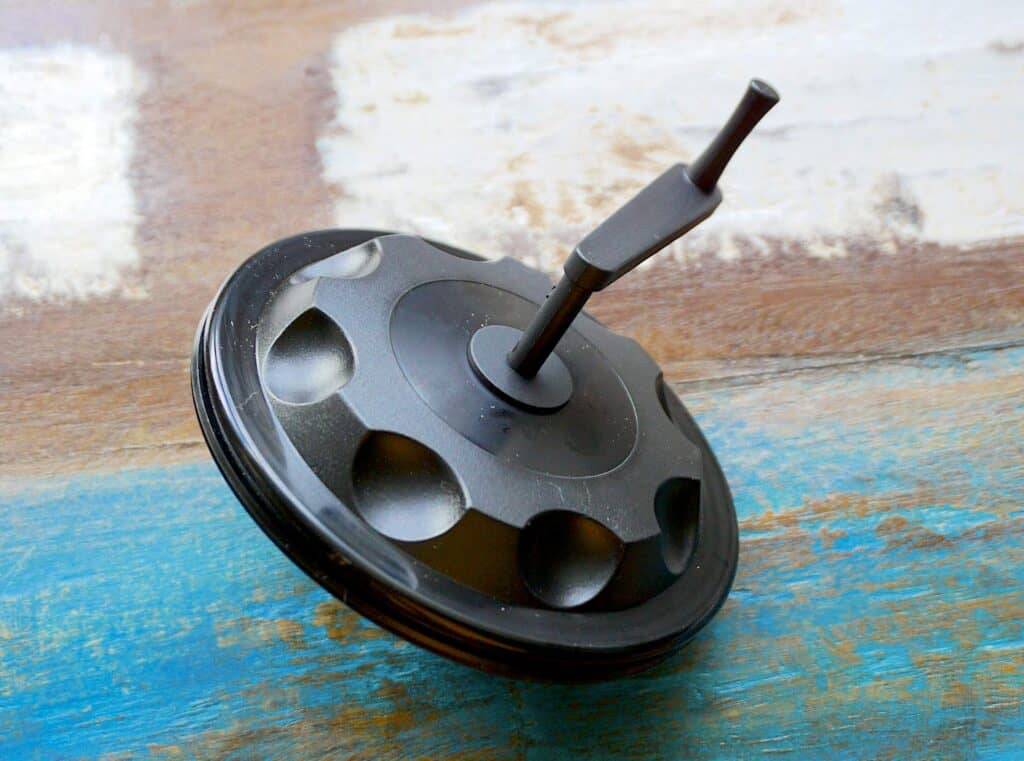
In terms of the clamp itself and its inherent construction? The principle difference between the original Mk.I clamp and the MkII+ is a rubber band that circles the inside of the clamp to protect the label from the bath water.
PROBLEMS
It was this clamp that I found problematic.
Firstly, when I clamped a record, ready for cleaning, I placed the vinyl record in between the outer clam shells where the vinyl is the meat in the sandwich, as it where. Then I rotated the clamshells, via the built-in screw thread, to tighten the clamp, making it waterproof and protecting the labels.
I then placed the vinyl in the bath, secured the clamp axles with the shaft locks, rotated the record with the built-in crank handle to clean the vinyl itself, carefully lifted the vinyl out of the bath, drip dried for a few moments and then attempted to remove the clamp.
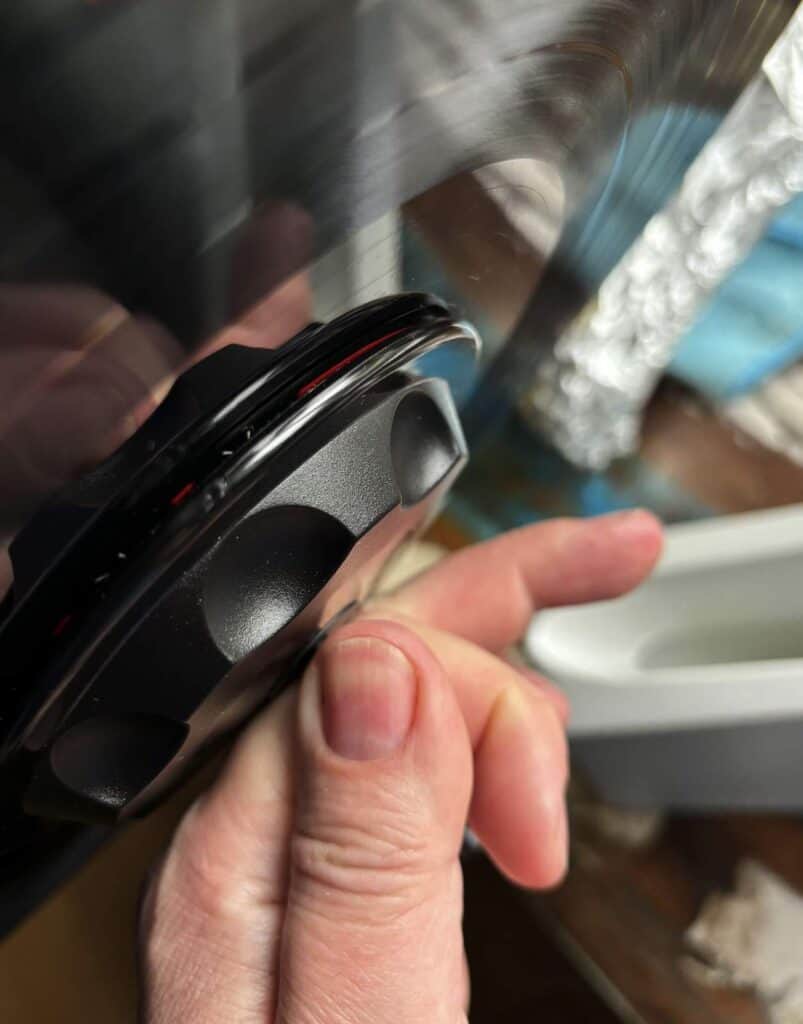
It wouldn’t move. The clamp was stuck.
No matter how much pressure I added to the clamp, it would not rotate in order for me to remove the clamp. What I had to do was grip the outer rim of the clamp with my finger tips, pull and then simultaneously twist to unlock. That did the job, I could remove the clamp using that technique but it hurt my finger tips, was cumbersome and could result in an accident, dropping the vinyl as you tried to get to grips. So no, that had to change.
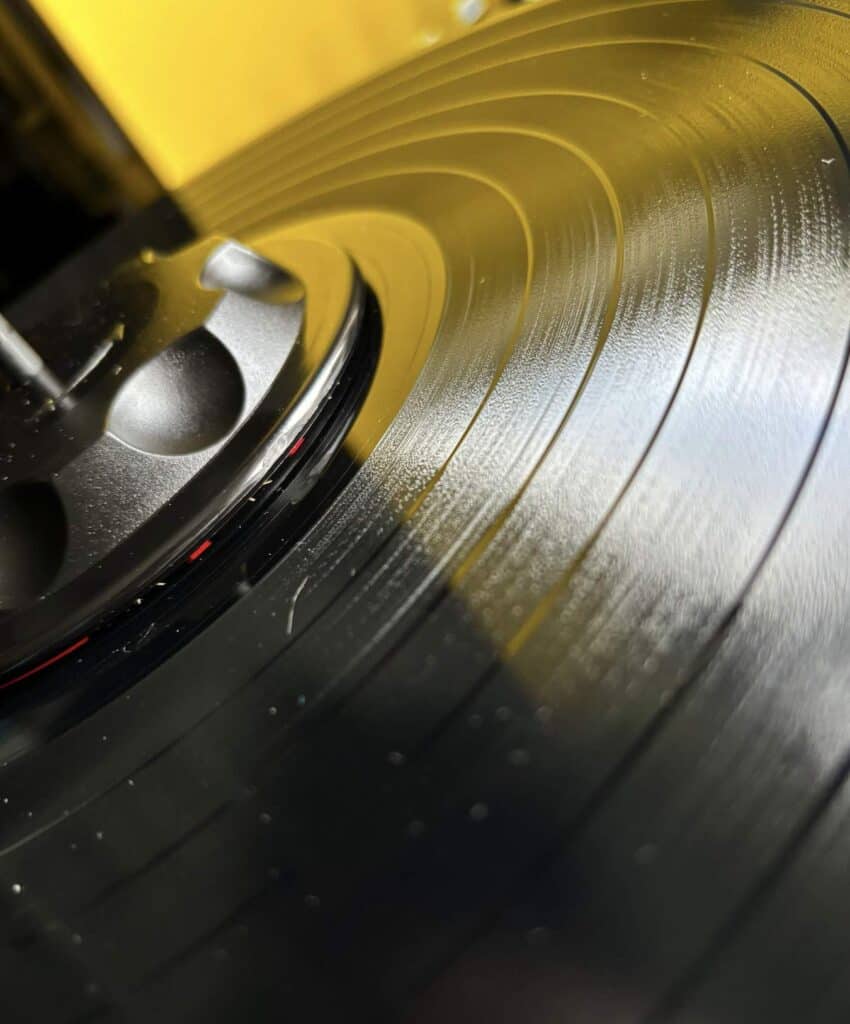
So I grabbed some Petroleum Jelly spread the substance over the rubber ring to lessen the friction across the rubber area, removed as much of the Jelly as possible but hoped that a micro film of the stuff would stay in place.
So I tried again, repeating the process. That worked. The Jelly lowered the friction. Trouble was, the clamp was no longer water proof. The Jelly let a little bit of water into the outer clamp area. So I cleaned the entire clamp area with Isopropyl Alcohol as a sort of reset.
Silicon spray was another option but I wondered if that might have the same water-leaking result. Another option was a gentle roughing up of the rubber ring with fine sandpaper.
LABEL ISSUES
I was about to try that but, before I did, I noticed a more important problem. Fitting the clamp to a record with an older red Columbia label, I noted that with the clamp in place, I could see parts of the record label peeking out of the clamp, That is, parts of the label itself lay outside of the rubber ring of the clamp. So, no matter how good the rubber ring was, no matter if I set at it with sandpaper, none of that would matter because the outer part of my Columbia label was going to get wet either way (see below for the results which did just that).
This was a basic design problem, therefore.
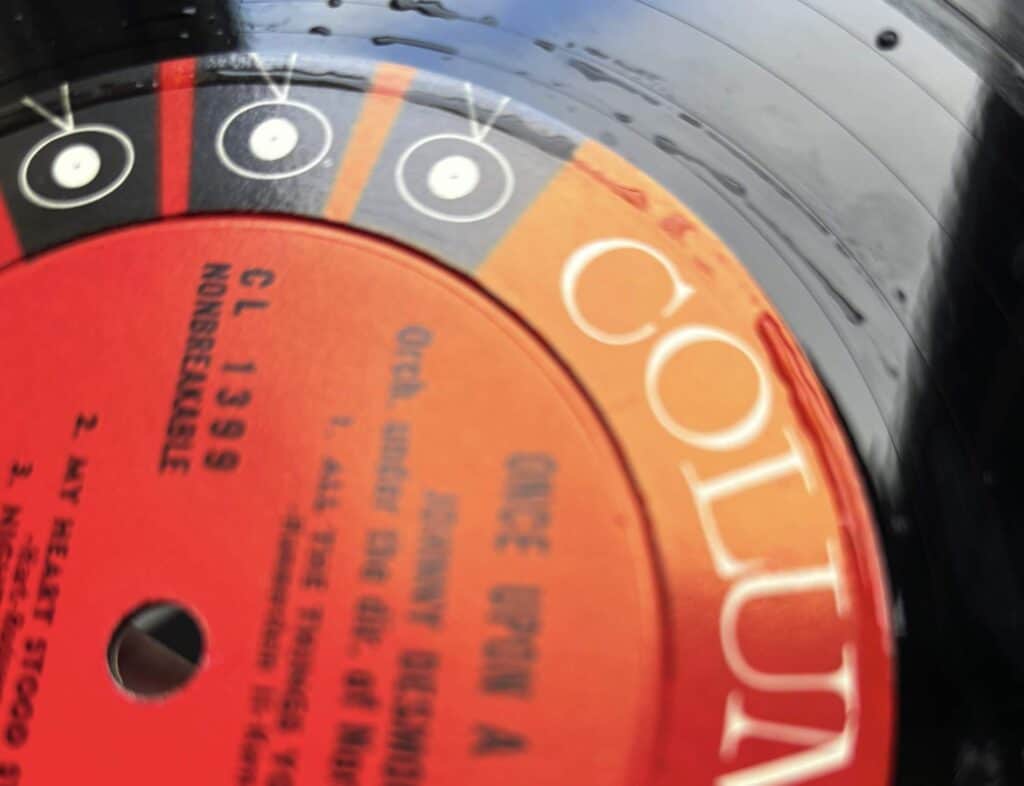
How to solve that then? I wondered if it might possible to remove the actual rubber ring so I tried to lever it out with a flat-headed screwdriver and yes, the ring emerged. I did that with both clamp halves. So then, two rings emerged.
I showed these images to Knosti and it also now recommends that you remove the rubber rings from the Mk.II+ clamp. At least while Knosti continues it’s own internal investigation. If and when I hear any conclusions about that investigation, Ill be sure to pass them on to you.
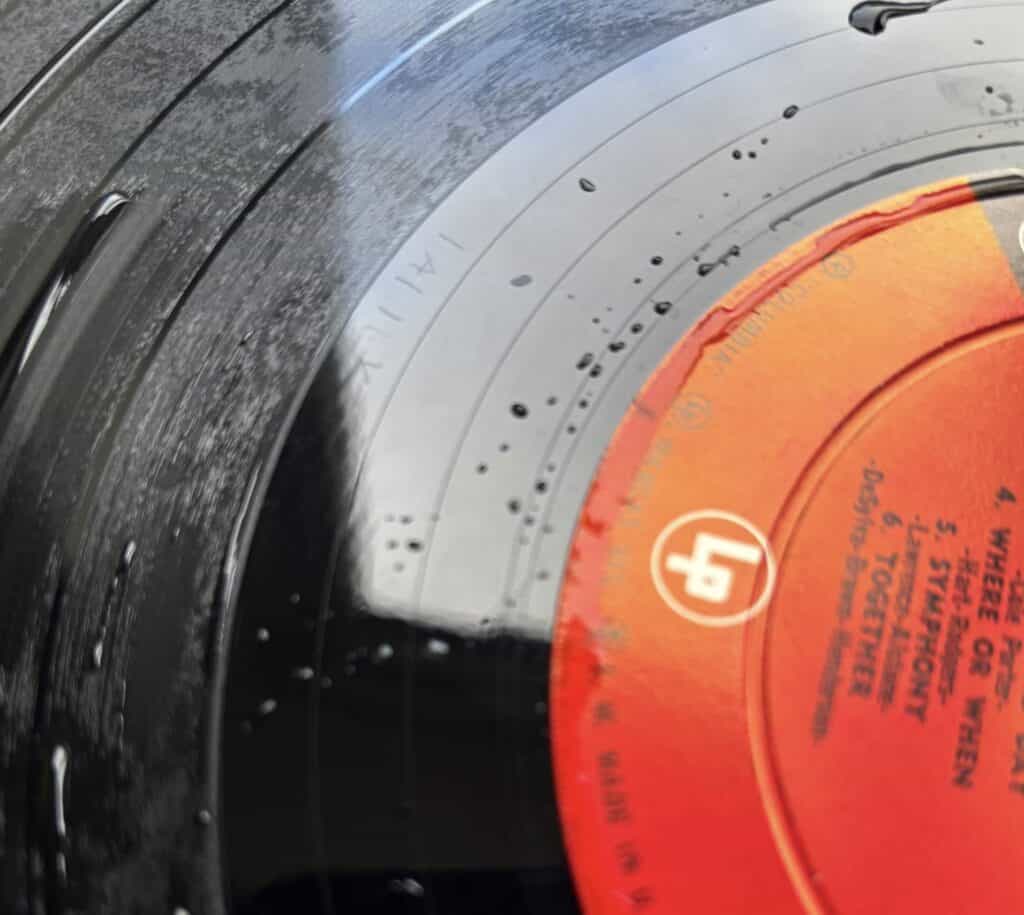
So I put the rings to once side. What was left was a bare clamp. Basically, after that quick mode, I was left with the same inner clamp design then, as featured on the Mk.I Disco Antistat.
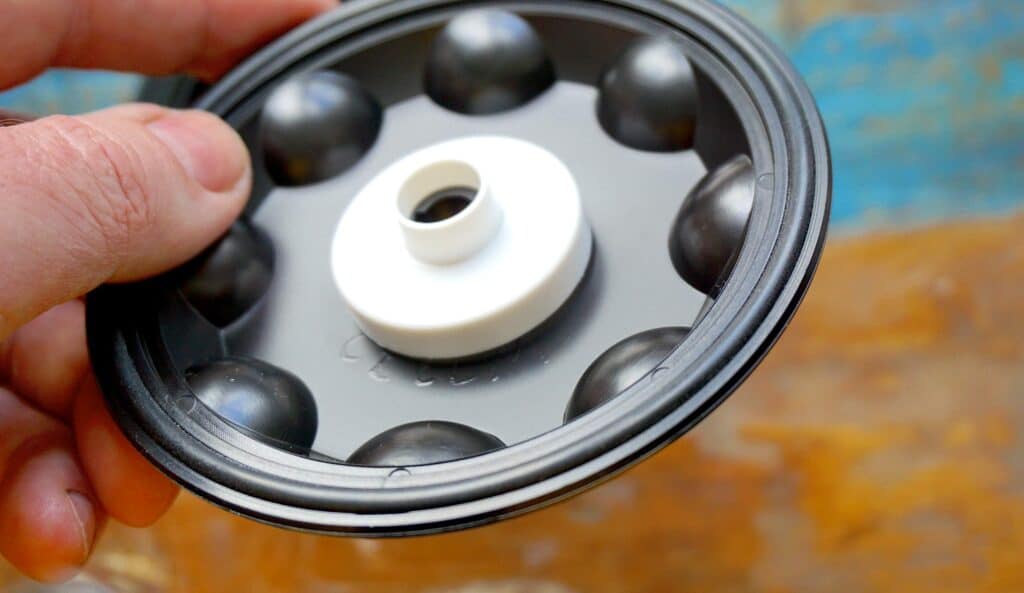
So I clamped that same Columbia record with my newly modified clamp, rubber rings now removed. I placed that back in the Mk.II+ bath, rotated the record to clean, removed it, could now easily rotate the clamp to remove it from the record and…?
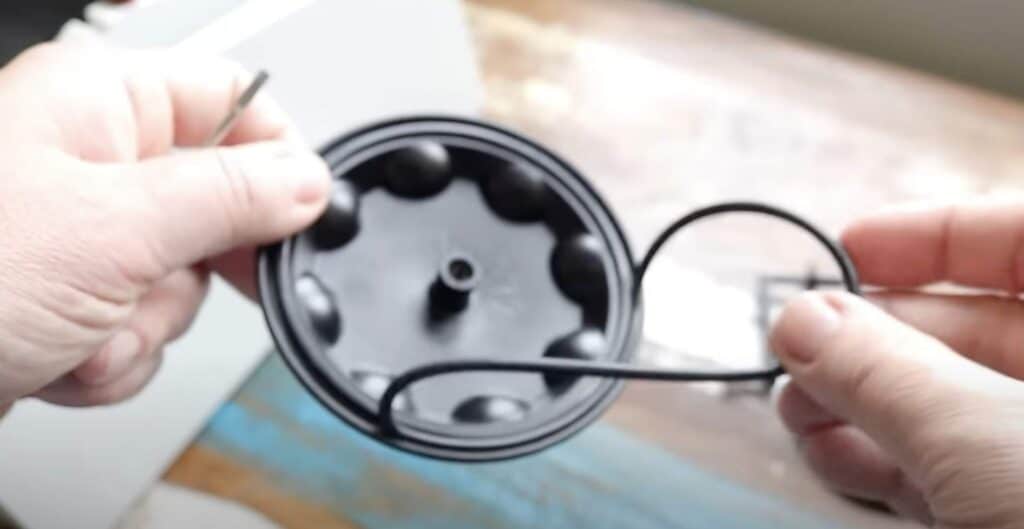
That solved the case! All was well. The label remained dry. Basically, the clamp from the Mk.II+ was performing exactly like a Mk.I. In fact, it was now no different from a Mk.I.
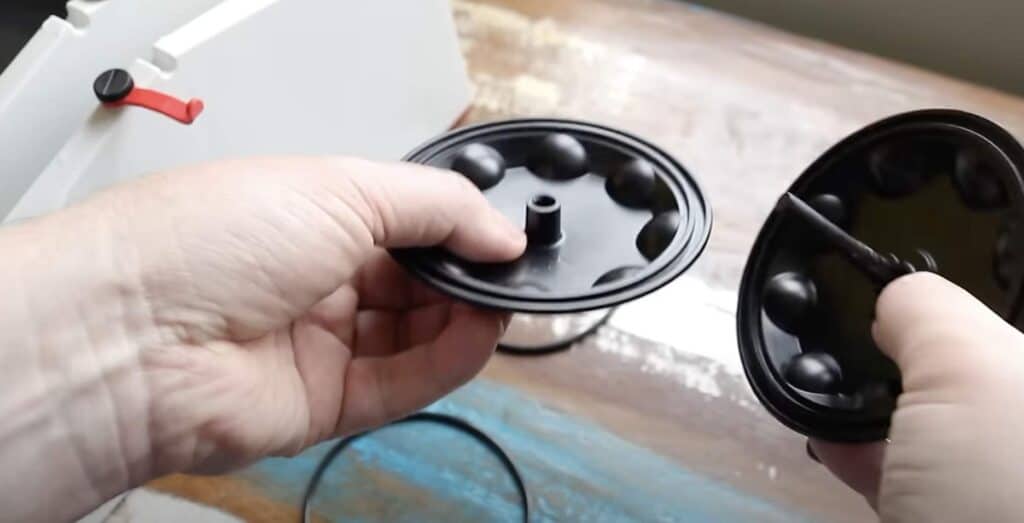
There is one, less important issue with the clamp but this relates more to the crank handle.
THE CRANK
When using the crank handle to turn the record in the Mk.II+ bath, that is pretty effective in a clockwise direction. If I then want to reverse the direction and go anti-clockwise I have to stop the vinyl, physically grasp the vinyl and push it a little into anti clockwise to then push the bristles in the bath into the opposite direction (a bit like changing gear I suppose), them crank the handle anti clockwise. That, I’m afraid can, on occasion, unscrew the clamp, letting water in. 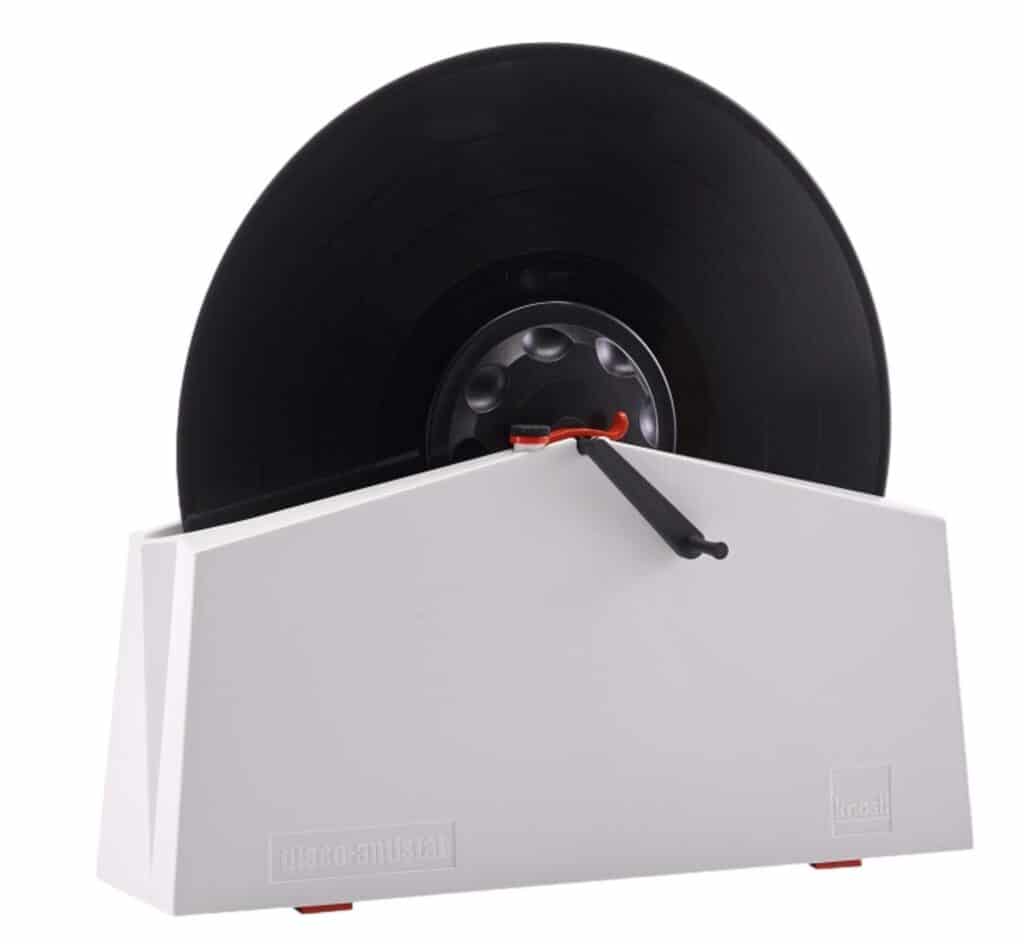
So instead, I found I had to run through a clock wise cycle of cleaning then, once completed, lift the vinyl out of the bath, flip it over and do more clockwise cleaning but the vinyl would now be cleaned in the opposite direction, if you’re still with me.
This is a bit of a palaver but it’s the only way to clean the grooves in both directions with the crank handle, if that’s what you like to do.
And that, my friends, is basically the review of the Knosti Disco Antistat Vinyl Record Cleaner. Everything was going just swimmingly, until we got to the clamp. So how should I rate this cleaner. Should I even recommend it?
CONCLUSION
To repeat, I love the Mk.I Disco Antistat to bits. The Mk.II+ Disco Antistat improves upon the Mk.I in almost every way. There are substantial and genuine enhancements right across the board here. Well, almost right across because there is a stumble before you get to that end point. The clamp. That darned clamp. Firstly, although the rubber ring is an effective water barrier, it prevents removal of the clamp after cleaning. More serious than that though, the rubber ring is positioned too close to the spindle area of the label. It should be moved further outwards, at the very circumference of the clamp itself.
Yes, there are many differently sized record labels out there but to say that this clamp works with some record labels and not others? Well, that will put off many a prospective buyer, I am sure. As I’m sure Yoda once said to his pupils: a vinyl cleaner should either work or not.
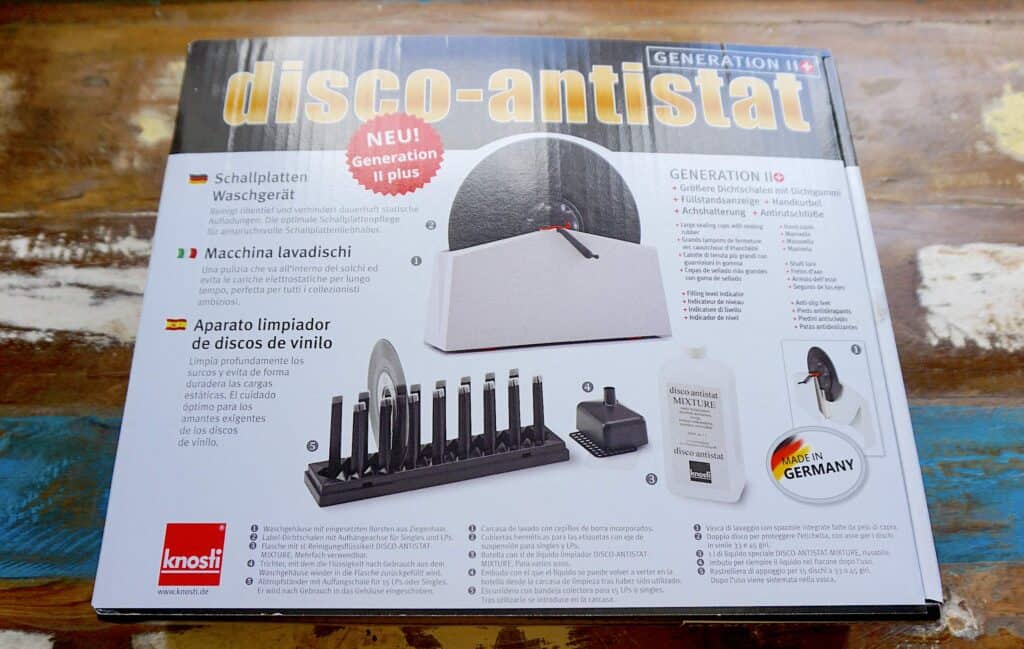
And this one has issues.
But as we have seen, those issues disappear when the rubber sealing rings are removed. And don’t forget, you will need to remove the rubber rings on both halves of the clamp.
Once done, the Disco Antistat Mk.II+ clamp then effectively turns into an older Mk.I-style clamp while the rest of the Mk.II+ design now becomes a true upgrade and an effective replacement for the Mk.I.
So yes, if you buy the Disco Antistat Mk.II+ vinyl record cleaner, you will need to do a quick mod on the clamp to get it to perform at its peak but, once done, you will have a brilliant and effective cleaner at your disposal.
As a final upgrade for the Mk.I? The Disco Antistat Mk.II+ is a cracking enhancement, the perfect upgrade. I’ll be upgrading my own Mk.I immediately.
CODA
Never added one of these before. There’s a first time for everything though, eh?
Some of you, right now, will be shouting at your screen, “But this is, out of the box, a faulty product! The rubber bands fitted to the clamps? They are an issue!” And yes, if my sole aim here was to punish Knosti, then yes, I would be giving this product a, what, 6/10? Something like that? But that would be needlessly vindictive, would it not? Helping neither the company nor you.
Also, prospective buyers would approach this review, they would check out the rating first, not bother to check out the rest of the review and not touch the Mk.II+ with a barge pole.
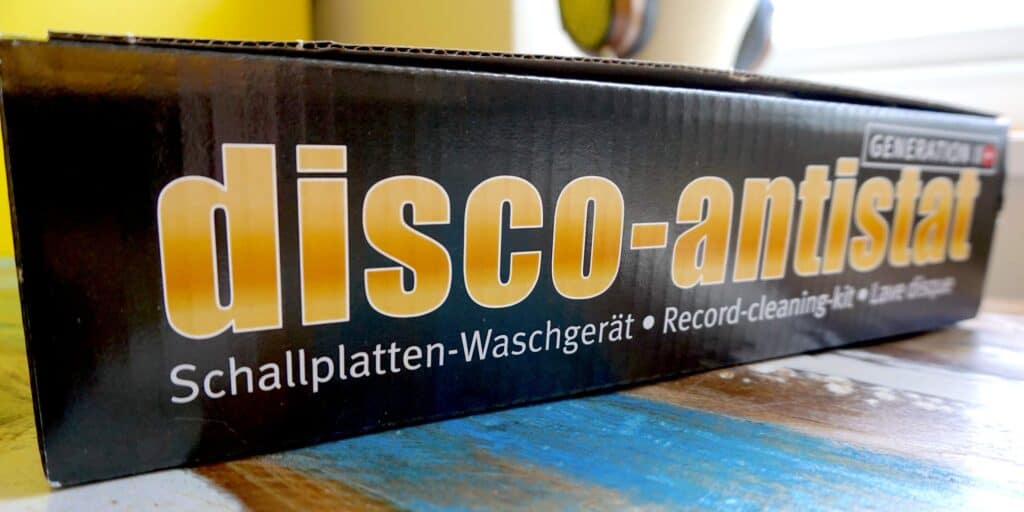
When, in fact, with a non-destructable 20 second mod (well that’s how long it took me), you’ve got a pretty special product on your hands. My aim then was not to punish the protective buyer. But also be assured, I have informed Knosti that this award-winning rating arrives with a modding caveat. It’s not an out-of-the-box rating.
DISCO ANTISTAT MK.II+ VINYL CLEANER
Price: £110 (Prices vary, depending where you shop)
BUY HERE:
EUROPE – https://amzn.to/4cPzEt3
Website: www.knosti.de
GOOD: chassis colour, water level markings, feet, removable brushes
BAD: the clamp
RATINGS: 8




First of all thanks for a fantastic review and a great website.
I had / have a similar problem with this cleaner.
With albums I have managed to sort it out by turning the handle anti clockwise straight after cleaning, and usually it releases. I had a big problem with singles though, mainly because I wasn’t using the singles adapter (I thought it was only for singles without the middle) but knosti’s customer service put me right and sent me pictures of how to use correctly (their customer service is really excellent btw). The instructions in the manual are pretty sparse regarding using the singles adapter so I also told them they could improve that aspect (this is ongoing apparently). Anyway I still have issues with singles despite that, so I will try sanding down the silicon rings as you mentioned (Knosti also gave me this advice).
Otherwise I ‘ll try removing the rings altogether as you recommend. I checked with Knosti who said I am free to try , but said they stood by their design while looking into improvement solutions which might take a while.
Also regarding the comments on rust on the brushes inserts, it is clearly stated in the instructions that the brushes should never be cleaned with tap water. I clean with distilled water but haven’t had the machine long enough to detect problems with long-term use.
Keep up the good work !!!
Martin
Many thanks for reporting your experiences Martin. All good stuff and I’m sure very useful for others reading about your experiences too.
Hi Paul,
Knosti’s talk about looking into the O-ring issue is so much hot air. When I cotacted them, suggesting Teflon O-rings which are readily available, they did not even have the courtesy to comment. Since changing to Teflon O-rings I have had no problems during multiple uses.
Regards,
Roy Dick
Hi
What size O ring is required?
Hi Guy,
The O-ring details are as follows:
Supplier: O-ring Stocks Techniparts (23-08-2024)
Size: 94 x 3 mm
Part Number: W578.8375
Price: € 14.2727
Regards,
Roy Dick
Thanks, Roy. Much appreciated.
Hi there, this is a good read thanks. I am considering buying one of these soon. There seems to be some mkII+ for sale that rather than having ready mixed solution say: 200ml Disco-Antistat Ultraclean concentrate (article no. 1302000) for record cleaning (makes 5 liters of cleaning solution), and I contacted Knosti about it, this seems to be the standard of what they ship now so you have to buy the distilled water you need to go wit it also. If this makes 5 litres of solution I am not clear how many times that fills the cleaner as I am not sure how much fluid you put in the device, assuming its around 500ml? Knosti still said to filter and reuse the fluid you make up yourself, but if 5 litres is lets say 10 uses I’d be tempted to not reuse the fluid anyway.
Hi, many thanks. The company’s own liquid is serviceable although not perfect. I much prefer my own system you can find that under the features tab in the vinyl care section. Part one of my cleaning system for manual vinyl cleaners. I recommend having a read of that first. Then see what you think. I think it’s more efficient as a cleaner to Knosti’s own product.
Hi there I did end up getting this product which as I mentioned seems to be an update on the updated one you reviewed. It’s not premixed solution, but is 200ml that 40ml of which can be diluted in their supplied 1litre bottle (on the bottle it says it is alcohol free by the way). I have used distilled water from a UK supplier on amazon. So it’s effectively 10 full baths of cleaning solution as the bath takes slightly under 500ml. I have not found an issue with the label clamp if its done up tight which does make it slightly difficult to undo at times but at least the label is untouched by it. I have turned clockwise each vinyl 10 times at a steady pace. With there just being 7 slots on the drier I have then waited until they are dry and put away before doing any more. The first batch was 13 records before I felt it was looking like it was not clean enough fluid, second batch 15 records. I don’t have a second bath to rinse the records, plus Knosti advised to not rinse as they said the anti-static properties would be lost. I have not noticed any residue on the stylus. On playback there is a noticeable difference sonically if that’s the right word, and some records that were bargain bin that with a cloth clean were still not great are now hugely improved. BUT and here is the thing for me so far noticeable on the quieter records I can hear a very quiet “Static-like” sound but the records are not sticking to the platter like often they could do due to static. So my assumption here is I am hearing very quietly the sound of the dried on solution. So great in some ways but not in others. older records rescued, yes, newer records loud static pops gone, but a very quiet background static introduced that you only notice when the records are quieter. I am wondering if after a few play throughs the records will get quieter. I expect if I raise this with Knosti they will advise I should have used their own distilled water, but I would not think that’s the root of this. Was your dissatisfaction with the supplied solution because of similar results or something else?
Hi Harvey – I’m not a fan of the Knosti liquid – new or old – I just don’t think it’s very effective. And a rinse is essential. You can also tackle anti static issues more efficiently with a Zerostat gun. I would advise reading my Manual Cleaning Guide here first, digest that, then come back to me if you have further questions: https://theaudiophileman.com/vinyl-cleaning-guide-part-1-manual-cleaning/